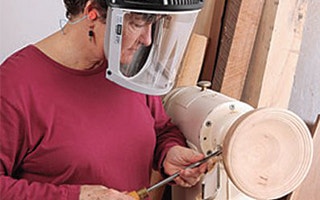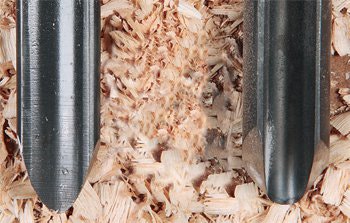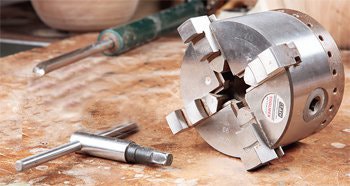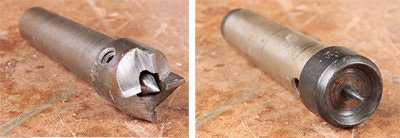Common Wood Turning Misunderstandings


In her years as a woodturner, Betty Scarpino has come across many common misconceptions about the craft. I’ve seen it too often: a person learns something new, they misapply the knowledge, and bad things result. Heck, it still happens to me far too often! Fortunately, I’ve survived those events, mostly intact. I would like to share some easily misunderstood concepts about woodturning with the hope of decreasing confusion and adding to your enjoyment and safety. Some of these misunderstandings result from the plethora of new turning items currently available. Many new gadgets are excellent, but if you don’t take time to understand their proper use, they’ll cause problems.
Faceshields and Goggles

Dust, wood chips, and even whole pieces may go flying when you start turning, so facial safety gear is a must. I wish I could decree that no lathe would start until the operator is wearing a face shield! Goggles are for preventing splinters from entering someone’s eye. A 9" bowl, spinning at 2,000 RPM, is much larger than a splinter. If it, or some portion of it, flies off the lathe, it will smash your face. Enough said?
Tool Rest Height Confusion
The most common question I get when I demonstrate spindle turning is, “At what height do I set the toolrest?” My answer: set your tool-rest height so that the cutting happens at or above the center line of the spindle. If it’s too high, the tool won’t cut but it’ll still be safe, and all you need to do is lower the toolrest. If it’s too low, that’s when it’s unsafe. If the tool-rest is positioned at or above center, there’s resistance between the wood and the tool’s cutting edge. If the tool-rest is too low and the cutting action happens below center, there’s no resistance, and in fact, the rotation of the wood pulls the tool away from the tool-rest. If a catch happens, the tool could be pulled away and flung at an innocent bystander. A word about those “S” curved tool rests. Well, two words: bad design. They don’t work for their intended purpose, so don’t waste your money. Instead, buy that chunk of figured wood you’ve been coveting.
Gouges Galore!
Spindle gouges are flatter than bowl gouges, bowl gouges (like the one on the right) cut deeper flutes, perfect for rounding bowl turnings. There are so many new turning tools on the market, even I’m sometimes confused — and I haven’t even mentioned different grinds! Let me offer this to help you get a handle on the differences:

Spindle gouges have a profile that is flatter than bowl gouges, and they have a flute that is more shallow. Conversely, the profile of a bowl gouge is round and the flute is deeper. A combination gouge is somewhere in the middle, and depending on how you grind the bevel, it can be used for turning spindles or bowls.
Roughing gouges are only for spindle turning. Their tang is generally narrow, yet the size of the cutting edge is large. This disparity between tang and cutting edge puts a lot of torque on that tang. That’s fine for spindle turning; however, for bowl turning, with diameters much larger, that downward pressure is greater, and those tangs can break.
Here’s where beginners get confused: instructors use the phrase, “rough out a bowl.” Not knowing about torque and tang size, a student grabs his roughing gouge to attack a large bowl blank. Bad things happen. For bowl turning, use a large, sturdy bowl gouge.
Variable-speed Challenges
Here’s another example of new technology causing a potential hazard. With variable-speed dials, it’s easy to crank up the speed and forget it was set for spindle turning. Imagine what happens when a large bowl is subsequently attached to the lathe and the operator doesn’t remember to reduce the speed setting? If he’s quick enough, he can reach for the dial or the power plug and avoid disaster, but if not, he’s in the way and becomes target practice. I won’t mention names ... but a group of woodturners I know decided to have a contest to see who could turn a bowl the fastest. While that’s not necessarily a bad concept, the addition of a high-speed setting caused the first person’s bowl to fly off the lathe. Ironically, the guy on the receiving end of this disaster was the same guy who conceived of the contest. I think it took six stitches to stem the flow and repair the damage to his forehead. Always check the speed dial, especially before mounting anything to your lathe.
Chuck Envy

Take your chuck off every once in a while to clean it out and check to make sure the jaws haven't become too loose.
Here’s my theory of why there are so many lathe chucks on the market: when woodturning first became popular, demonstrators toured around, stopping at various local clubs. Each club had a different make and model lathe. In order to be able to easily attach wood to those lathes, the demonstrator invested in a chuck that had a good variety of spindle adapters. The demonstrator attaches a hunk of wood to the lathe to show different cuts, and at some point during his demo, someone asks, “What kind of chuck are you using?” The demonstrator answers the question but doesn’t think to tell the attendee why he’s using a chuck or that a chuck isn’t necessarily the best solution for bowl turning. The rookie turner ends up thinking he needs that particular chuck, so he orders one. His friend, not wanting to be without the latest toy, also buys one. Manufacturers see growing interest in chucks, so they begin manufacturing new and better ones. And so it goes ... we now have plenty to choose from.
Some chucks are excellent. Some are more useful as paperweights than for their intended purpose. You can figure out which one you like best by trying out a friend’s or by taking a class where chucks are used. Hey, if you don’t mind the expense, order several and decide which is best for use on your lathe and which works best as a paperweight! Personally, I find that chucks are excellent for roughing out and returning green bowls. They’re also useful for spindle turning, especially when turning boxes and production items. There are large- and small-capacity chucks. Select accordingly. Occasionally clean and check the jaws for wear and tear. Those jaws do loosen over time, and that slippage can cause problems. Additionally, (again) please keep the speed of your lathe reasonable — chucks aren’t designed for 100 percent secure holding, especially with large-diameter bowls.
Drive and Live Centers

Old turning equipment used a spur drive center on the headstock in conjunction with a dead center mounted on the tailstock.
Recently, a student sent me a message asking why the piece of wood he’d attached to the lathe between centers wouldn’t stop spinning when he was trying to make a cut, no matter how much he tightened the tailstock. After a series of messages back and forth, I finally figured out the problem. He was using a live center in the headstock instead of a drive center. A drive center directs a lathe’s power to spin the wood. They are inserted into the spindle of the headstock and have two purposes:
1. they hold the wood onto the lathe
2. they grip the end of the wood so that the lathe’s power can turn it.

Newer lathes use more efficient and stable safety drive centers and live centers for mounting.
For turning between centers, it’s useful to use a live center in the tailstock (instead of the old-fashioned dead centers). Live centers rotate because they are equipped with bearings. This is nifty because it allows the center to rotate as the wood spins, thus preventing the wood from burning, yet still holding it onto the lathe. With the now widespread use of live centers for the tailstock, manufacturers turned their attention to centers for the headstock: what could be invented that would not only be useful but generate sales? I’d have to say that the spur drive center is on its way out — safety drive centers are the current favored gadget. The problem: some of these new drive centers look a lot like the live centers. It’s confusing for beginners!
And confusing for most woodworking stores. They are not yet savvy about the new safety drive centers. When my student went into his local woodworking store to ask for a drive center and came home with a live center, the mistake was understandable: drive/live; center/center; tailstock/ headstock. Spur drive centers are certainly all right to use, but understand that they hold the wood so securely that when a catch happens, the “give” could be the tool instead of the wood. Safety drive centers also hold the wood securely (and rotate the wood properly), but they will allow for the wood to release its spinning motion when a catch happens. They also teach students to use a more controlled cut while keeping them out of trouble.
Skill Versus Technique
If what you are doing while turning isn’t working well, step back and analyze the situation. Perhaps the solution isn’t that you aren’t skilled enough. It could simply be that you are misapplying a technique or using the wrong tool. Be safe and have fun turning!
Keep the inspiration coming!
Subscribe to our newsletter for more woodworking tips and tricks
